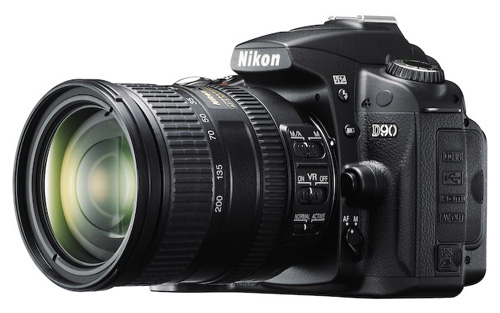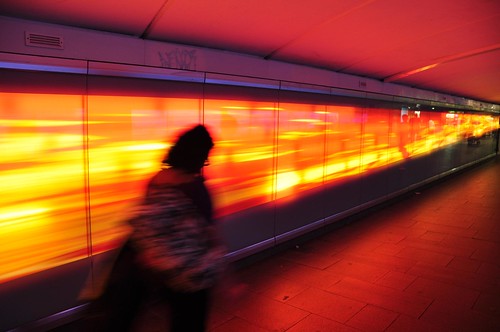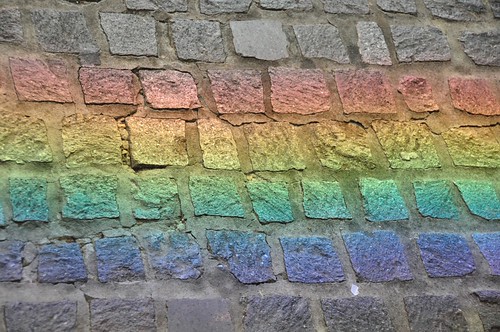I recently tested a Nikon D90 SLR digital camera with 18-200 VR II Lens for a few weeks to compare it against the Canon EOS 500D SLR Digital Camera I’d tested just beforehand. As expected the D90 offers more advanced features, better battery life and more configuration options than the Canon 500D/550D but was also larger and significantly more complex to learn how to use.

I would recommend the Nikon D90 to an enthusiast photographer who has used SLR’s before, plans to often use manual settings, is willing to read the (very long) user manual and take a lot of practice photos to learn how to best configure the camera.
In the hands of someone like that the Nikon D90 is capable of taking excellent photos such as the 2 example photos below which I took while testing the camera. I consider these 2 photos to be amongst the Top 20 photos I have ever taken.
I do NOT recommend the Nikon D90 to a novice photographer who has only previously used a compact camera, will never read the camera manual or learn how to configure the camera manually because they’d be barely using 20% of what the D90 is capable of and therefore wasting their money.
This kind of photographer is better off spending less money and getting a camera more suited to their skills and usage scenarios such as the Panasonic TZ series which is great for travelling or the Canon S90 which is a powerful camera in a compact package.
If they feel they’ve outgrown the capabilities of compact cameras and want to learn how to use an SLR I’d suggest having a look at the Canon 500D Digital SLR which is cheaper than the Nikon D90 and has a much easier learning curve.
Cost of Nikon D90 and Lenses
{{lls}}
At time of writing the Nikon D90 camera body alone can be bought online for AUS$1,229 (less $200 cashback).
If you’re on a tight budget I’d suggest buying the Nikkor AF-S DX 35mm f1.8G lens for $349 which is great value, small, low weight and really fast wich will give you great performance in low light conditions without needing flash.
If you have a bigger budget for a camera lens and want an all-rounder that can take good photos in 90% of circumstances get the Nikkor AF-S 18-200mm f3.5-5.6G ED VRII for $1109 which is perfect for photo walking in your neighborhood and for travellers/backpackers who can’t carry multiple lenses.
Ideally you would buy the 35mm f1.8G as well as the 18-200mm VRII to give you more photographic options.
Photo Gallery Taken By Nikon D90 with 18-200 VR II Lens
One of the best ways to judge a camera is to view photos taken by it in a variety of circumstances. The Nikon D90 test photos below were taken in a mixture of bright sunny light, grey overcast conditions, wide angle and zooming in all the way.
Other People’s Reviews of Nikon D90
The D90 viewfinder is amongst the best you’ll find on any APS-C camera and it sits above the highest-resolution screen we’ve yet seen on a camera of this class. The buttons are well chosen and sensibly positioned, and the two-dial interface is a pleasure to use.
The image quality, whether at base ISO or the higher settings, is excellent even if it can need a bit of tweaking of the internal settings to tailor the output to specific needs.
The early talk about the D90 was about its video capability and indeed it does record HD videos – good ones by digital stills camera standards. But don’t let that distract you, this is a camera which lets nothing get in the way of taking photos. Its degree of configurability results in long menus but they’re generally well arranged and color-coded to minimize the likelihood you getting lost in them.
After using and testing the D90 extensively, it’s hard to think of a better enthusiast-level camera.
–DP Review
The Nikon D90 looks like a genuinely excellent camera for the intermediate photographer, and a great choice as a full-featured, light weight body for those who own a Nikon D200 or D300. The addition of video is ground-breaking, and will open up new possibilities that will be fun to explore, even though I wish it handled motion better than it does.
All in all, the Nikon D90 presents a truly compelling proposition for intermediate photographers – Or novices looking for a camera with plenty of capability to grow into. For Nikon shooters it offers a great step up from the previous D80 or previous entry-level Nikon DSLRs like the D50, D40, or D40x. For more advanced Nikon users, it makes a great second body for those whose main camera is one of Nikon’s higher-end models, like the D200 or D300.
Bottom line, the Nikon D90 is an exceptionally well-rounded digital SLR offering, with just about everything an aspiring photographer will need, and quite a few of the advanced features found on the higher-priced SLRs in Nikon’s line, but at a lower price. Very highly recommended
– Imaging Resource
Other People’s Reviews of Nikon 18-200 VR II Lens
Just occasionally, the old cliches are still the best, and with the 18-200mm VR the phrase ‘jack of all trades, master of none’ springs immediately to mind. It’s a lens which delivers somewhat flawed results over its entire zoom range; where it’s sharp, it has heavy distortion, and when that distortion comes under control at the long end, it loses sharpness.
Its close-up performance is reasonable, but not spectacular, and overall it will likely be outperformed optically by a cheaper combination of standard and telephoto zooms. So for a certain type of photographer interested mainly in absolute image quality, this may well cause it to be regarded as nothing more than an expensive snapshot lens.
But to dismiss the 18-200mm VR based purely on its optical quality is to miss the point quite fundamentally. The whole idea of such a lens is to allow the photographer to travel light and never miss a shot while changing lenses, or indeed not to have to risk water or dust entering the camera in adverse conditions.
So what you do get for your money is a hugely flexible zoom range which can handle the vast majority of photographic opportunities, coupled with excellent autofocus and vibration reduction systems. And all of this is wrapped up in a relatively compact package, with build quality which feels solid without being excessively heavy. It really is a lens you can leave on your camera all day long and scarcely miss a shot, and it has to be said, this makes it a lot of fun to use.
– DP Review
One of the things that first had me considering a switch to Nikon from Canon ages ago was the Nikon 18-200mm VR lens. I do a lot of “photo walking” – well, not so much in the sense of the group event that term has come to encapsulate – more just going out for long walks with my camera and taking pictures of what ever I see a long the way. I always liked the idea of being able to go out with one lens. There have been super-zooms around for ages, but the Nikon 18-200 VR was in a class of its own until recently.
So just over a week ago I finally took the plunge and got a nice shiny new (well, ok, matte) Nikon 18-200 VR. It did not disappoint. Let me make one thing clear before I go on though. this is not a pro quality lens. It’s not perfect by any means, nor would you expect it to be. However, for a lens of this range of focal lengths, it’s pretty damn good.
– Thomas Fitzgerald
Tips to Help You Use a Nikon D90 Effectively
The following Nikon D90 tips were written by my friend Wolf Cocklin who uses a Nikon D90 as his main digital SLR camera.
First thing is set the time correctly. Sure you bedroom clock is 5 min out, the living room clock is 6 mins early and the car clock has no idea when it last got changed for day light savings. The reason is that the time on the camera is part of what you can do with your images later. Geotagging from software for example relies on the time being set accurately on the images. Also setting the time means that you have the ability to accurately sort the images later based around events.
Set the Image Comment to your name. This way every photo will have a (C) on it. The other advantage is that if your camera is stolen any photos will in all likely hood still have your details on them.
Turn on the Framing Grid that way you always have a horizon line to play with or a vertical line to frame straight photos off. This makes handholding level shots much easier.
Set Image Quality to RAW + JPG. You will want RAW’s to play with. There are some that say just shoot JPG, but that requires a lot of skill and practice. RAW gives you the ability to do a lot more with your shots in post production. The reason for shooting in JPG as well is that if you don’t have access to your main computer with the RAW codec on it, you can still show and share the JPG files.
You have a programmable function button on the front of the camera… programme it. I have mine set on AF Area Modes which means that I can scroll through Single Point, 3D, Dynamic or Auto. Great if you are trying to shoot something and it moves out of focus, you can switch focus mode without taking your eye of the view finder.
Turn off the Built in AF Assist Illuminator… (also referred to as that damned annoying light that in low light situations tells everyone you are taking a photo before you do and stops the moment from being spontaneous)
If you haven’t purchased the ML-L3 Remote Control for the D90, go and buy it. Whilst you are waiting for it, you can always just use the self-timer mode to start long exposures. However you will be limited to only 30 Seconds of long exposure… you need the remote to do the D90’s maximum of 30 Min.
Get into the habit of turning the camera back into Auto (No Flash) Mode whenever you finish shooting. This way no matter what things you have set up (with the exception of manual ISO), the camera will get that in a hurry shot. There is nothing more frustrating that picking up the camera after doing long exposures for example and waiting 30 seconds for it to finish taking a shot the next day. The No Flash means that your flash wont go off when you least expect it as well!
As soon as you have got your images off the camera Format the disk. Why, because this does reduce the risk of file system errors and secondly you reduce the risk of walking out of the house with a full disk of images. There is the two button (Trash and Metering Option, or in the Set Up Menu Option.
And finally leave all but one your lenses at home unless you need it. Sure you can buy a big bag and lug around 5 kg of camera equipment around with you. But stop and think what are you going to need whilst you are just wandering around. I have a Sigma 18-200mm that sits on my camera. That is the lens I leave on it, why because that is the lens I am going to use 80-90% of the time. I have dedicated lenses I do take with me when I need them, but your all purpose lens will get you most of the shots you need and save a lot on physio bills!
Always turn off the focus beep, it makes you look like an amateur and is annoying to your subjects.
For more tips visit Ken Rockwell’s Detailed Nikon D90 Users Guide



Leave a Reply